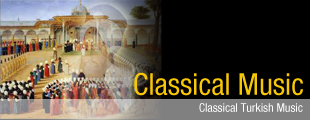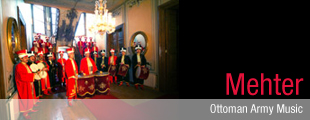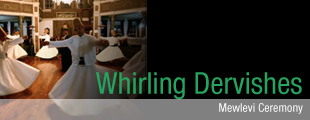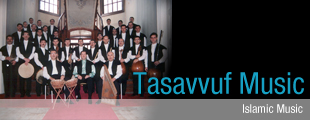

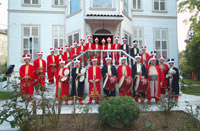 Our ensemble has performed hundreds of concerts both in Turkey and abroad including three KATS in itself. We have both performed classical repertory feeling responsibility of historical duty and given concerts with jazz and symphonic orchestras as a matter of being open to newness
Our ensemble has performed hundreds of concerts both in Turkey and abroad including three KATS in itself. We have both performed classical repertory feeling responsibility of historical duty and given concerts with jazz and symphonic orchestras as a matter of being open to newness
HISTORY
We firstly meet with mehter; world’s oldest military band, on the Orhun Inscriptions. The military band that is described as “Kübürge” and “Tuğ” in these inscriptions, is also explained in Divan-ü Lügat-it Türk (XI. century) that mehter was making music in the presence of khans ( supreme rulers of turkish tribes). The ‘’Tuğ’’s that are composed of instruments küvrük(kös), tomruk (davul), çenk (zil) and nay-i türki, were performing music on the wars and special days. Besides ‘’Tuğ’’ has been the symbol of rulership in Turks. So that, Sovereign of Anatolian Seljuk, II. Gıyaseddin Mes’ud has given the authority of rulership to Osman Gazi; the founder of Otoman Empire by sending him tuğ, sancak (flag), boru (horn), zil (cymbal) and davul (drum). That is to say; mehter is the same age as Otoman Empire’s founding.
Mehter has carried on its development with the modifications on the instruments, due to 1826, the date it was abolished. Bringing the world’s first military band into life again was in 1914. After this date, mehter has been kept alive till nowadays.
Besides of mehters’s military aspect, the Ministry of Culture has established the mehter section of our ensemble, in 1992, to bring up and show its part that is performing civil music and called ‘’Guilds Mehter’’ and intent to give a place to spacious repertory. In this manner, the mehter is provided to relive with all its aspects and encouraged to be introduced all over the world.
Our ensemble has performed hundreds of concerts inluding three KATS ; in İstanbul and lots of cities in Turkey and abroad as Japan, Germany, Portugal, etc. In all of these countries, we have performed classical repertory feeling responsibility of historical, cultural and artistic duties and prepared common programs with jazz and symphonic orchestras as a matter of being open to newness
ORDER OF CONCERT
The mehter which has lined up as a circle in the first years, started to arrange in row like a half-circle (crescent) afterwards. It stil keeps this crescent form today.
The person who directs the mehter and called Mehterbaşı (master of mehter) stands in the middle of the crescent. As the crescent-star of our flag…The mehter concert starts with the sazs (instruments) and voices coming to the stage. Then, the person named çevgânbaşı ( main mehter aga), calls Mehterbaşı to the stage by saying ‘’ Vakt-i sürur u safa, Mehterbaşı hey, hey “. Mehterbaşı comes and greets. He greets the public after each opus performed and he announces the next one at this time. At the end of the concert, Mehterbaşı prays a special arranged prayer for this purpose called ‘’Gülbank’’. Concert ends in this manner. Concerts that Mehter gives like this way are described as ‘’nevbet’’.
Besides nevbet, Mehter can also perform music while walking. Way of walking is as; Mehterbaşı in the front, mehter behind, starting with right foot and greeting the public by turning right and left in every three steps.
Previously, it has been done five times; before of each namaz (rituel of Islamic worship), and afterwards, performed only before midafternoon namaz. Mehter doesn’t only perform nevbet in the state of war. Besides all of these monotonous and daily actions, it was performed also in ambassador parades, sword parades, birth and circumcision feasts of shahzadahs’ and sultans’, when victory tidings are given, when guilds become a master workman and in these kinds of entertainments.
Mehter is composed of groups called ‘’kat’’s. Kats depend on the amount of instruments in the mehter. The mehter may have one kat up to 13 kats. For example; in a mehter which has three kats; there are three drums, three nakkare (a small kettledrum), three cymbals, three horns, three zurnas, a kös (a big drum) and 12 çevgans (four times of the other sazs). Only Padishah has mehter of 13 kats.
REPERTORY
Mehter does not only perform marsch as it is thought. Its repertory have kâr, karçe, beste, semai, fasıl songs, frontier and Rumelia folk songs, peşrev and saz semaies that are available with its own structure.
COSTUMES
Master of groups wear red robes, red hats, red shalwars, yellow üç eteks (a traditional dress of three skirts) and yellow scarfs. Other musicians wear dark blue robes, dark blue hats, dark blue shalwars and colored üç eteks and red scarfs. Çevgans also wear like the master of groups.
EXPLANATIONS
Mehter is composed of zurna, boru, nakkare , zil, davul and kös groups.
Çevgâni : Person who is playing çevgan. Çevgan is an instrument that has cymbals on and is played by swinging from up to down. This instrument is played by choros in the mehter. Each chorist has a çevgan on his hand. (Foto)
Zurna-zen : Person who is playing zurna.(Foto)
Boru-zen : Person who is playing boru.(Foto)
Nakkare-zen : Person who is playing nakkare. Nakkare is composed of a couple of leathers strecthed on two little copper bowls and is played with two little bagets called “zahme”. (Foto)
Zil-zen : Person who is playing zil. Zil is resembling a cymbal. (Foto)
Davul-zen : Person who is playing davul (drum). (Foto)
Kös-zen : Person who is playing kös. Kös somewhat resembles tympany.(Foto)
